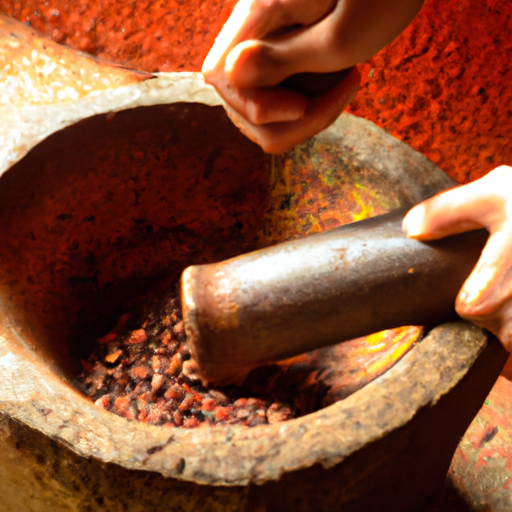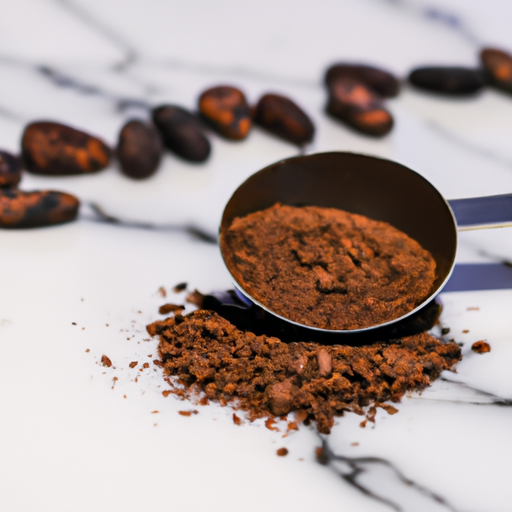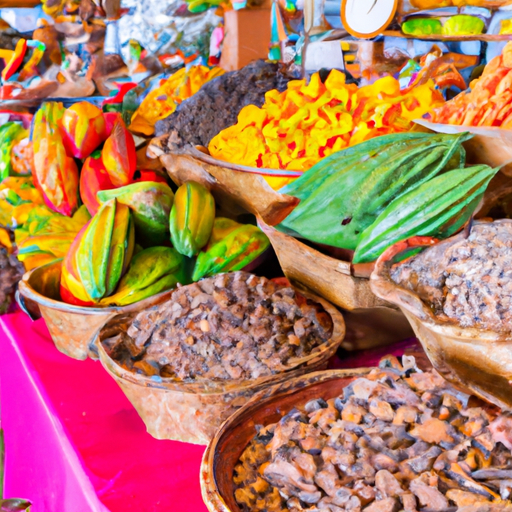I’ve always been a lover of all things chocolate, but recently, I’ve discovered the joy of working with raw cacao nibs. These little gems have a rich, intense flavor that is unmatched by regular cocoa powder.
However, to fully unlock their potential, I needed to find the best way to grind them into a smooth and creamy cacao paste. Through countless hours of experimentation, I’ve learned the ins and outs of this process.
In this article, I’ll be sharing my findings and guiding you through the steps to achieve the perfect cacao paste. From understanding the characteristics of cacao nibs to choosing the right equipment and experimenting with grinding techniques, we’ll leave no stone unturned.
So, if you’re ready to take your chocolate game to the next level, let’s dive in and explore the best way to grind raw cacao nibs into cacao paste.
Key Takeaways
- Electric grinders are recommended for grinding cacao nibs into paste, with blenders and food processors as alternatives
- Pulse blending allows for better texture control, while longer blending times may generate more heat and alter taste
- Roasting cacao nibs at low temperature intensifies flavor
- Finer grinds create a smoother texture, while coarser grinds give a rustic result
Understand the Characteristics of Cacao Nibs
Now that you’ve got your hands on some cacao nibs, let’s take a moment to understand their unique characteristics.
Cacao nibs have a rich and intense taste profile, with bitter notes and a hint of fruity flavor. They are packed with nutritional benefits, such as antioxidants, fiber, and minerals like magnesium and iron.
When it comes to sourcing and quality factors, it is important to choose organic and fair-trade cacao nibs to ensure their purity and ethical production.
Additionally, the shelf life of cacao nibs can vary depending on storage conditions, but they generally have a long shelf life if stored in a cool and dry place.
Understanding these characteristics will help you choose the right equipment for grinding the cacao nibs into a smooth and creamy paste.
Choose the Right Equipment
When it comes to grinding raw cacao nibs into cacao paste, choosing the right equipment is crucial.
There are two main options to consider: manual and electric grinders. Manual grinders give you more control over the grinding process but require more physical effort, while electric grinders are quicker and easier to use.
Alternatively, blenders and food processors can also be used as alternatives, but they may not provide the same level of precision as dedicated grinders.
Manual vs. electric grinders
To achieve the best results, you should consider using an electric grinder instead of a manual one when grinding raw cacao nibs into cacao paste.
When comparing the cost of manual versus electric grinders, it is important to note that electric grinders are generally more expensive upfront. However, they provide a more efficient and consistent grinding experience, which can save you both time and effort in the long run.
Electric grinders have a higher grinding speed compared to manual grinders, allowing you to achieve a smoother and finer cacao paste in a shorter amount of time. This speed is particularly advantageous when working with larger quantities of cacao nibs.
Moving on to alternative options, blenders and food processors can also be used for grinding cacao nibs, but we will explore these further in the next section.
Blenders and food processors as alternatives
Blenders and food processors can serve as convenient options for transforming cacao nibs into a smooth and creamy paste. When using these appliances, it is important to consider the blending techniques and grinding time to achieve the desired consistency.
| Blending Techniques | Grinding Time |
|---|---|
| Pulse Blending | 2-3 minutes |
| Continuous Blending | 5-7 minutes |
| Low Speed Blending | 8-10 minutes |
By using pulse blending, you can control the texture of the cacao paste more effectively. This technique involves blending the nibs in short bursts to prevent overheating and to maintain the integrity of the cacao’s natural flavors. Alternatively, continuous blending can be used for a smoother and more uniform paste. However, longer blending times may result in increased heat generation, potentially altering the taste of the final product. Once the cacao nibs have been transformed into a paste, it is time to prepare them further for use in various recipes.
Prepare the Cacao Nibs
First, grab your trusty food processor to start preparing those cacao nibs into a smooth and creamy cacao paste. Understanding the origins and sourcing of cacao nibs is crucial in creating a rich and authentic flavor. Ensure that your cacao nibs are of high quality and have been ethically sourced.
Additionally, exploring different roasting techniques can enhance the depth of flavor in your cacao paste. Experiment with different temperatures and durations to find the perfect balance. Begin by preheating your oven and spreading the cacao nibs evenly on a baking sheet. Roast them at a low temperature, around 250°F, for approximately 20 minutes, or until they become fragrant and slightly darker in color. This step is vital in releasing the natural oils and intensifying the flavor of the cacao.
Transitioning into the subsequent section, now that the cacao nibs are perfectly roasted, it’s time to delve into various grinding techniques.
Experiment with Grinding Techniques
Now that you’ve got your perfectly roasted cacao nibs, it’s time to get creative and experiment with different grinding techniques. The fineness of the grind can greatly affect the texture and mouthfeel of your final product. When experimenting, consider the grinding speed and particle size. A faster speed can generate more heat, potentially impacting the flavor and texture. Particle size also plays a role – a finer grind creates a smoother and creamier texture, while a coarser grind gives a more rustic result.
Now, let’s move on to the next section and learn how to adjust the consistency and texture of your cacao paste.
Adjust the Consistency and Texture
When adjusting the consistency and texture of cacao paste, I find that adding a liquid such as cocoa butter or coconut oil helps to achieve the desired results.
The addition of these liquids not only helps to create a smoother and creamier texture but also enhances the overall flavor of the cacao paste.
It is important to grind the mixture until it is completely smooth and free of any lumps or graininess for optimal results.
Adding liquid (e.g., cocoa butter, coconut oil)
To achieve the desired smooth consistency, you may want to consider incorporating a small amount of cocoa butter or coconut oil into the grinding process of your raw cacao nibs. Adding liquid not only helps in achieving the right texture but also enhances the flavor of the cacao paste. When incorporating cocoa butter or coconut oil, it is important to explore different ratios to find the perfect balance of richness and creaminess. Additionally, trying different sweeteners like honey or agave syrup can add a hint of sweetness to the final product. Here is a table showcasing the different ratios and sweeteners you can experiment with:
| Ratio of Liquid to Cacao Nibs | Sweetener |
|---|---|
| 1:1 | Honey |
| 1:2 | Agave |
| 1:3 | Maple |
| 1:4 | Stevia |
| 1:5 | Dates |
By incorporating liquid and experimenting with ratios and sweeteners, you can create a cacao paste that is not only smooth and creamy but also perfectly sweetened. Now, let’s move on to grinding until smooth and creamy.
Grinding until smooth and creamy
To achieve a velvety texture and heavenly consistency, grind your cacao nibs until they transform into a luscious, creamy delight. Implement effective grinding techniques using a high-quality grinder or a stone grinder specifically designed for cacao nibs. This ensures a smooth and even consistency throughout the process. Adjust the paste’s consistency by adding small amounts of liquid, like cocoa butter or coconut oil, for a creamy texture and enhanced flavor profile.
Monitor the grinding process closely to avoid over-grinding, which can result in a grainy texture. Once the desired smoothness is achieved, it’s time to move on to storing and preserving the cacao paste for future use.
Proper storage techniques are crucial to ensure the longevity and freshness of your precious cacao paste.
Store and Preserve Your Cacao Paste
To store and preserve your cacao paste properly, follow these methods:
- Keep your cacao paste in an airtight container to prevent exposure to moisture and air.
- Store it in a cool and dark place, such as a pantry or cupboard, away from sunlight and heat sources.
- Avoid storing it near strong-smelling foods to prevent flavor contamination.
- Consider refrigerating or freezing your cacao paste if you want to prolong its shelf life even further.
By following these guidelines, you can preserve the flavor and texture of your cacao paste, ensuring its freshness for an extended period.
Now, let’s explore flavor variations and discover exciting ways to enhance your chocolate creations.
Explore Flavor Variations
Discover the endless possibilities of flavor combinations that will take your chocolate creations to a whole new level. By exploring different flavor pairings, you can create unique and delicious variations of cacao paste. Not only will this add excitement to your recipes, but it will also allow you to experience the health benefits of various ingredients. To help you get started, here is a table showcasing five flavor variations and their potential benefits:
| Flavor Pairing | Health Benefits |
|---|---|
| Cacao and Coconut | Boosts metabolism and adds a creamy texture |
| Cacao and Mint | Aids digestion and provides a refreshing taste |
| Cacao and Hazelnut | Enhances brain function and adds a nutty flavor |
| Cacao and Orange | Boosts immune system and adds a citrusy twist |
| Cacao and Almond | Supports heart health and adds a subtle nuttiness |
Incorporating these flavor combinations allows you to unlock the full potential of cacao paste in your recipes. Transitioning into the subsequent section, let’s explore how to incorporate cacao paste into various dishes and desserts.
Incorporate Cacao Paste into Recipes
Let’s dive into the creative world of culinary possibilities by incorporating the rich and velvety cacao paste into a variety of mouthwatering recipes. When it comes to incorporating cacao paste into desserts, the possibilities are endless. Here are five ways to elevate your sweet treats with the indulgent flavors of cacao paste:
- Add a dollop of cacao paste to your favorite brownie recipe for an extra fudgy and decadent texture.
- Whip up a creamy chocolate mousse by blending cacao paste with avocado, coconut milk, and a touch of sweetener.
- Infuse your homemade ice cream with cacao paste for a rich and intense chocolate flavor.
- Incorporate cacao paste into your cake batter for a moist and chocolatey delight.
- Create a velvety smooth chocolate sauce by melting cacao paste with coconut cream and a pinch of salt.
In addition to its delicious taste, cacao paste also offers several health benefits. It is rich in antioxidants, which can help reduce inflammation and support heart health. The high levels of magnesium in cacao paste promote relaxation and can improve sleep quality. By incorporating cacao paste into your desserts, you can enjoy both the indulgence and the health benefits it offers.
Now, let’s move on to the next section and enjoy the fruits of your labor.
Enjoy the Fruits of Your Labor
When it comes to enjoying the fruits of my labor after grinding raw cacao nibs into cacao paste, I can’t help but indulge in delicious homemade cacao-based treats.
From rich and velvety chocolate bars to decadent truffles, the possibilities are endless.
Not only do I get to satisfy my own chocolate cravings, but I also love sharing my creations with friends and family, who are always excited to taste the results of my hard work.
Indulging in homemade cacao-based treats
If you’re craving a delicious homemade cacao-based treat, there’s no better way to indulge than by grinding your own raw cacao nibs into rich and velvety cacao paste. Not only does this process allow you to have complete control over the quality and flavor of your cacao-based treats, but it also opens up a world of possibilities for creating homemade cacao-based skincare products. Raw cacao consumption offers numerous health benefits, including antioxidant properties and the potential to improve mood and cognitive function. By grinding cacao nibs into cacao paste, you can harness these benefits and incorporate them into your skincare routine. To give you an idea of the versatility of cacao-based treats, take a look at the table below:
| Cacao-Based Treats | Description |
|---|---|
| Cacao Truffles | Decadent chocolate balls with a creamy center |
| Cacao Smoothie Bowl | A nutritious and indulgent breakfast option |
| Cacao Face Mask | A rejuvenating treat for your skin |
By exploring these homemade cacao-based treats, you can enhance your well-being and pamper yourself from the inside out. And don’t worry, there’s more to come! In the next section, I’ll show you how to share your creations with friends and family.
Sharing your creations with friends and family
Share the delicious homemade cacao-based treats you’ve created with your loved ones and watch as their eyes light up with joy and their taste buds come alive with every delectable bite.
When it comes to sharing your cacao creations, there are a few tips and tricks that can make the experience even more enjoyable.
Firstly, consider presenting your treats in a visually appealing way. Use decorative plates or arrange them on a dessert platter to add an extra touch of elegance.
Additionally, get creative with your cacao-based desserts. Experiment with different flavors and textures by adding ingredients like nuts, fruits, or spices. This will not only enhance the taste but also make your creations more unique and memorable.
Lastly, don’t forget to share the recipes! Your friends and family will appreciate the opportunity to recreate these delightful treats in their own kitchens.
So, get ready to impress your loved ones with your creative cacao masterpieces!
Frequently Asked Questions
Can I use a regular blender or food processor to grind cacao nibs into cacao paste?
Yes, a high-powered blender or food processor can be used to grind cacao nibs into cacao paste. To achieve the smoothest texture, ensure the nibs are fully ground and scrape down the sides periodically.
What is the recommended ratio of cacao nibs to cacao butter when making cacao paste?
The recommended ratio of cacao nibs to cacao butter when making cacao paste is 3:1. This balance ensures a smooth and creamy texture, while preserving the rich flavor and health benefits of cacao paste.
How long can I store homemade cacao paste and what is the best way to preserve it?
To store homemade cacao paste, it should be kept in an airtight container in a cool, dry place. It can be preserved for up to 6 months. Proper storage helps maintain its quality and prevents spoilage.
Are there any specific flavor variations or additions that can be incorporated into cacao paste?
There are several flavor variations and additions that can be incorporated into cacao paste, such as vanilla, cinnamon, or sea salt. These additions not only enhance the taste, but also provide additional health benefits.
Can cacao paste be used interchangeably with cocoa powder or chocolate in recipes?
Cacao paste and cocoa powder differ in flavor and texture. Cacao paste has a richer, smoother taste and a thicker texture. To incorporate it into recipes, melt it gently and mix well for optimal results.
Can I Use Melted Raw Cacao Nibs to Make Cacao Paste?
Yes, you can use melting raw cacao nibs to make cacao paste. Simply heat the raw cacao nibs on low heat until they melt into a smooth and creamy consistency. Once melted, the cacao paste can be used for various chocolate recipes, such as truffles, bars, or hot cocoa.
Conclusion
In conclusion, after all the hard work and dedication, you’ve successfully transformed those stubborn cacao nibs into silky smooth cacao paste. Bravo!
Now, you can indulge in the rich flavors and luxurious textures that only homemade cacao paste can offer.
Remember, the key is to experiment and find your own grinding techniques to achieve the perfect consistency.
So go forth, my fellow chocolate enthusiasts, and let your taste buds embark on a decadent journey of pure cacao bliss.
Happy grinding!










